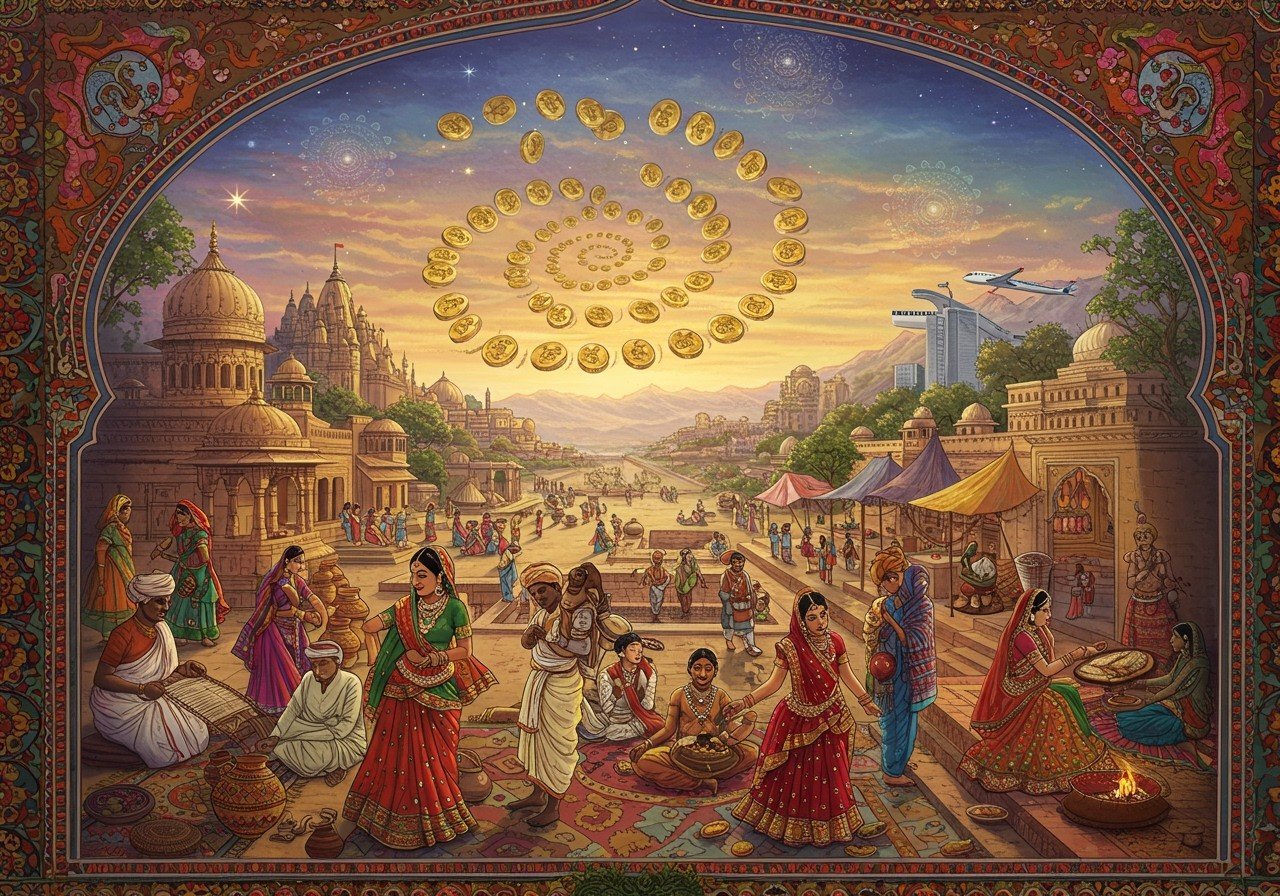
Tourism plays a vital role in India’s economy and culture. With its rich heritage and diverse landscapes, India attracts millions of visitors annually. This article delves into the multifaceted impact of tourism on India’s economy and culture, exploring both the advantages and challenges it presents.
Economic Impact of Tourism in India
Tourism significantly contributes to India’s GDP. According to 2023 data, the sector contributed over INR 19.13 trillion, surpassing pre-pandemic levels. This growth fuels job creation and infrastructure development, benefiting both the national and local economies. Furthermore, tourism generates substantial foreign exchange earnings, strengthening India’s financial standing.
- Contribution to GDP: In 2023, tourism contributed over INR 19.13 trillion to India’s GDP, exceeding pre-pandemic levels by 10%. This robust growth underscores the sector’s importance to the national economy. The World Travel and Tourism Council (WTTC) estimated that tourism generated ₹13.2 lakh crore (US$150 billion) or 5.8% of India’s GDP in 2021, highlighting its consistent contribution.
- Job Creation: The tourism sector is a major employer, supporting nearly 43 million jobs in 2023. This figure is projected to rise to 63 million by 2034, indicating the sector’s potential for continued employment growth. In 2022-23, 76.17 million direct and indirect jobs were created due to tourism in India, compared to 70.04 million direct and indirect jobs created in 2021-22.
- Foreign Exchange Earnings: Tourism is crucial for foreign exchange earnings. In 2023, it contributed Rs 2.3 lakh crores, a significant increase compared to 2022. These earnings contribute to India’s economic stability and international trade.
- Infrastructure Development: Tourism drives infrastructure improvements. The influx of tourists necessitates investments in roads, airports, and urban facilities, benefiting both visitors and residents. The Indian government has invested approximately $1 billion (Rs. 7,000 Crores) in tourism infrastructure to enhance the visitor experience.
- Growth of Related Industries: Tourism’s growth benefits related sectors. Hospitality, retail, transportation, and handicrafts experience increased demand, creating a positive ripple effect throughout the economy.
Cultural Impact of Tourism in India
Tourism fosters cultural exchange and understanding between people from different backgrounds. It encourages the preservation of historical sites, cultural heritage, and traditions, while also promoting peace and stability through cross-cultural awareness. However, it also presents socio-cultural challenges, such as increased living costs in tourist destinations and potential friction between tourists and locals due to differing values.
- Cultural Exchange: Tourism facilitates cultural exchange. Visitors experience India’s rich traditions and customs, while locals interact with people from diverse backgrounds, fostering mutual understanding and appreciation.
- Preservation of Heritage: Tourism incentivizes heritage preservation. Revenue generated from tourism can fund the restoration and maintenance of historical sites and the continuation of cultural practices.
- Promotion of Peace and Stability: Tourism contributes to peace and stability. By creating jobs and promoting cross-cultural understanding, it can help bridge divides and foster harmonious relationships.
- Socio-Cultural Issues: Tourism can also lead to socio-cultural challenges. Increased living costs, cultural commodification, and potential clashes in values between tourists and locals require careful management.
Environmental Impact of Tourism in India
While tourism can contribute to environmental degradation through pollution and resource depletion, it also motivates conservation efforts. Tourists’ interest in natural and historical sites encourages their protection. Ecotourism further promotes environmentally friendly travel, minimizing the negative impacts and supporting sustainable practices.
- Environmental Degradation: Tourism can negatively impact the environment. Pollution, resource depletion, and habitat destruction are potential consequences that need to be addressed through sustainable practices. Increased traffic, waste generation, and overuse of resources can strain the environment.
- Conservation Efforts: Tourism can drive conservation. The demand to experience natural and historical sites encourages governments and organizations to protect and preserve these valuable assets. Tourists’ demand for natural and historical sites can lead to increased efforts to conserve these areas.
- Ecotourism: Ecotourism promotes responsible travel. It focuses on minimizing environmental impact and supporting local communities while offering authentic cultural experiences. Ecotourism openly promotes environmentally friendly travel and seeks to ensure that visitors do not disturb the natural environment of flora and fauna, nor do they leave behind rubbish and hazardous materials, which can disrupt the delicate ecosystem.
Specific Examples of Tourism’s Impact
- Gujarat: Gujarat has become a tourism hotspot, attracting over 15.40 lakh tourists in 2023. This influx has stimulated the local economy and created numerous jobs.
- Medical Tourism: India is a growing destination for medical tourism, with a market size estimated at $9 billion in 2019. This sector provides specialized healthcare services at competitive prices, attracting patients from across the globe.
- Overtourism: Popular destinations face the challenge of overtourism. Pollution, overcrowding, and rising living costs negatively impact the environment and local communities. Pollution of water bodies like Dal Lake in Srinagar and the Ganga River due to waste generated by tourists. Overcrowding and vandalism at UNESCO World Heritage Sites like the Taj Mahal and Ajanta-Ellora Caves. Rising cost of living and real estate in tourist-heavy areas like Goa, displacing locals. Commercialization and loss of cultural integrity in places like Jaipur and Varanasi.
Government Initiatives and Future of Tourism in India
The Indian government is actively promoting tourism through initiatives like “Swadesh Darshan” and “Dekho Apna Desh.” These programs aim to improve infrastructure, enhance the tourist experience, and encourage domestic travel. The government’s @2047 vision targets 100 million inbound tourists, reflecting its commitment to the sector’s growth. Addressing challenges like sustainable tourism practices and managing overtourism are crucial for the long-term viability and positive impact of the industry. Diversification, visitor management, and community involvement can help balance the benefits of tourism with the need to protect destinations.
- Government Initiatives: The Indian government is investing in tourism development. Initiatives like “Swadesh Darshan” and “Dekho Apna Desh” aim to improve infrastructure and promote domestic tourism. The government is also working to improve infrastructure, connectivity, and the overall tourism experience in the country.
- Future of Tourism: Sustainable practices are essential for the future of tourism. Managing overtourism, protecting cultural heritage, and promoting responsible environmental practices are crucial for long-term success. The @2047 vision targets 100 million inbound tourists by 2047. The Travel and Tourism Development Index 2024 (TTDI) ranked India at 39th among 119 countries. India’s score has improved in prioritization of travel & tourism, safety & security, and health & hygiene.
How Poojn.in Supports Cultural Tourism
Poojn.in, India’s largest cultural goods and services store, supports cultural tourism by providing access to authentic puja items and religious materials. This allows both locals and tourists to engage in traditional practices. Our offerings include complete puja kits, brass and copper items, religious texts, and regional-specific ritual items. We also offer educational resources, travel-size puja kits, and pan-India delivery, catering specifically to the needs of cultural tourists. Explore our range of products at www.poojn.in or contact us at +91 3369029784.
For tourists interested in performing pujas during their travels, we offer a variety of camphor tablets, candles, ghee, and incense sticks. These items can enhance your spiritual experience while exploring India’s rich cultural heritage.
Conclusion
Tourism is a vital force in India’s growth, contributing to its economy, preserving its culture, and fostering global connections. By embracing sustainable practices and addressing the challenges of overtourism, India can ensure that tourism continues to be a source of prosperity and cultural pride for generations to come. Poojn.in is committed to supporting this journey by providing authentic cultural goods and services that enrich the experience of both domestic and international tourists.


